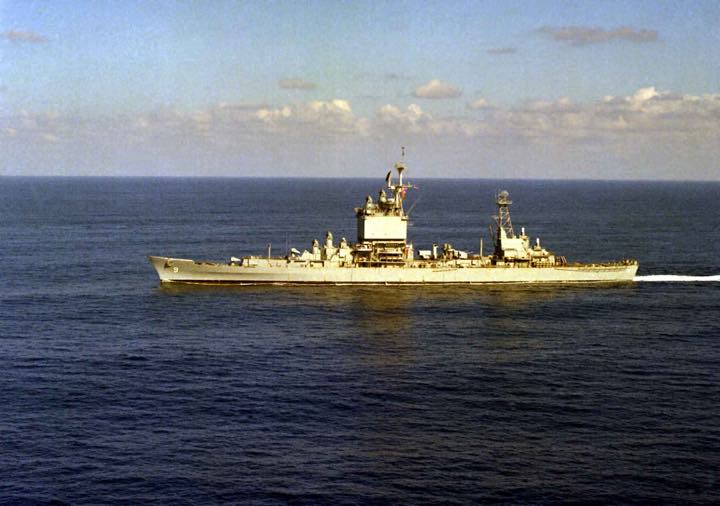Long Beach III CG(N)-9

Long Beach III
(CG(N)-9: dp. 15,540; 1. 721.3'; dr. 30'7"; a 30 k.; cpl.
1,160; a. 2 5", 1 Tail Mis., 2 Ter. Mis., 1 ASROC; cl.
Long Beach)
The third Long Beach (CG(N)-9) was originally ordered as CLG(N)-160. She was reclassified CG(N)-160 in early 1957, but was again reclassified LS CG(N)-9 on 1 July 1957. I,aid down as CG (N)-9, 2 December 1957 by Bethlehem Steel Co., Fore River Shipyard, Quincy, Mass.; launched 14 July 1959; sponsored by Mrs. Craig Hosmer wife of Congressmen Hosmer of California; and commissioned 9 September 1961, Capt. E. P. Wilkinson in command.
The first nuclear-power surface warship in history Long Beach was assigned to the Atlantic Fleet and home ported at Norfolk, Va. The guided-misf;ile cruiser conducted extensive shakedown~and testing of her complex weapons and propulsion systems from 2 October to 16 December 1961; her superlative performance proved the nuclear cruiser a highly capable and effective warship. Between 28 December and 6 January 1!~62 she conducted operational tests of her missiles off Puerto Rico, then sailed for Bremerhaven, Germany, arriving;, 15 January for courtesy calls in north European ports.
Returning to Norfolk 7 February, she trained on the east Coast and in the Caribbean, on 10 April Joining in
Atlantic Fleet exercises off North Carolina and Virginia LS flagship for Adm. Robert H. Dennison, Commander in Chief, Atlantic Fleet. She was reviewed by President John F. Kennedy and Vice President Lyndon B Johnson during this demonstration o naval power.
After overhaul and installation of new equipment at Philadelphia, Long Beach trained in the Caribbean and sailed 6 August 1963 to join the 6th Fleet in its Mediterranean peacekeeping operations. She returned to Norfolk 20 December for coastal and Caribbean operations through 28 April when she sailed for the Mediterranean to join attack carrier Enterprises (CVA(N)~5) and guided-mis sile frigate Bainbridge (DLG(N)-26) in the formation of the first all nuclear powered task group 13 May. The force operated in the Mediterranean testing its unique capabilities until 31 July when it sailed under Rear Adm. Bernard 1lL Strean from Gibraltar on an around-the~world cruise. This operation, "Sea Orbit", reminiscent of the cruise of the Great White Fleet in 1907{)9, demonstrated the strategic mobility of U.S. naval nuclear-powered surface forces independent of normal fleet logistic support. During 58 steaming days Long Beach steamed over 30,000 miles at an average speed of 25 knots, without being refueled or resupplied. In the course of the voyage, numerous foreign dignitaries visited the ship during visits off both coasts of Africa and in-port calls at Karachi, Pakistan; Melbourne, Australia; Wellington, New Zealand; and Rio de Janeiro, Brazil. An unqualified success, the operation proved to people the world over the tremendous increase in capabilities nuclear power brings the Navy.
Long Beach returned to Norfolk from this triumph 3 October to join in exercises off the east coast and in the Caribbean. On 4 June she sailed for the Global Strategy Conference at the Naval War College, Newport, where Vice Adm. Kleber S. Masterson, Commander 2d Fleet broke his flag in the ship. Back in Norfolk 23 June, Long Beach resumed training and upkeep prior to her transfer to the Pacific Fleet. She sailed 28 February 1966 for her new home port and namesake, Long Beach, Calif.. and arrived 15 March.
The summer of 1966 was spent in training and orienting midshipmen" in the tactics and operations involved in the modern nuclear Navy. After a period of leave and upkeep in the fall, Long Beach sailed 7 November from Long Beach for the Far East. She arrived on PIRAZ station on the 30th, and continued on that vital operation throughout most of her WestPac tour. From 8 to 27 April 1967 the nuclear-power cruiser made a cruise to Sydney, Australia. On the return portion of the trip back to Subic Bay, Republic of the Philippines, the ship made a stop in "Ironbottom Sound" on 23 April for a memorial service commemorating the battles fought and lives lost there in World War II. After the wreath-laying cere. mony, she steamed up "The Slot" at 30 knots, back toward a different war.
Long Beach arrived back at the west coast on 4 July where, after a well deserved period of rest, she resumed the exercises and operations which would keep her well prepared for her return to Vietnam the following year. This next deployment began when she once again left her home on 15 April 1968' As before, the cruiser spent most of her time on PIRAZ station, guiding the many planes which operated over North Vietnam. This tour of duty in West Pac ended with her arrival again at Long Beach on 16 November, where she remains into 1969.
 >
>